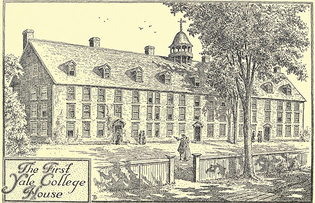
Manuscripts & Archives/Engraving by Theodore Diedricksen Jr.
Yale’s first Class of ’21—that’s 1721—slept, studied, and attended classes in one building facing the Green. This illustration is from Edwin Oviatt’s 1916 book “The Beginnings of Yale.”
View full image
The Class of 2021 may leave bittersweet memories of their final Yale years and their COVID-compliant commencement. As we celebrate their graduation in May, a look back to the previous Classes of ’21 provides a panorama of four centuries of Yale alumni.
The newest Class of ’21 will have around 1,500 graduates, the largest number in Yale’s history, thanks to the opening of two new residential colleges for their first year. Those not receiving financial aid paid a term bill of $74,900. They were taught by an arts and sciences faculty of nearly 1,200 professors, lecturers, and teachers. And after commencement, they will join a body of 175,000 living alumni.
In September 1721, Rector Timothy Cutler presented 14 Collegii Yalensis diplomas to the members of the first Class of ’21 at the fourth commencement held in New Haven, two months after Elihu Yale’s death. Gown and town looked forward to receiving his promised donation of an additional 10,000 pounds, but Yale died intestate. There was no legacy. Still, Yale’s donation in 1718 enabled the college to remain a private institution while it continued to be publicly supported.
Tuition was about 35 shillings, room and board about 4 shillings a week. The omni-functional college hall at the northwest corner of College and Chapel Streets (the current site of Bingham Hall) faced the Upper Green, which was occupied by the colony statehouse, Hopkins Grammar School, the prison and stocks, and the Town Burying Ground. Further east down the Green were the meeting house and the great marketplace where cows still grazed.
During ’21’s college years, in the reign of King George I, New Orleans was founded by the French, the Alamo was built, and Blackbeard was killed off the coast of North Carolina. The college faculty comprised the rector (renamed president in 1745) and two tutors. At the next commencement Cutler would reveal that he had converted to the Church of England and would be summarily dismissed. At the time, Yale had 105 living and five deceased alumni.
The Class of 1821 holds a special place in Yale history for promoting alumni associations and support. President Jeremiah Day ’95, inaugurated in the class’s freshman year, would remain in office for 29 years, the longest in Yale history. Tuition was $33; for each of three terms, room was $2–4 and board $65–75—with extra charges for sweeping, making beds, and other services. In 1821, US President Monroe was inaugurated for a second term, Missouri became a state, and Florida a US territory. One of the early iconic American popular novels was published that year: The Spy, a romance set in the American Revolution, establishing the reputation of James Fenimore Cooper ’06.
One hundred years later, the Class of 1921 graduated in one of the most significant years for Yale. Known as the Reconstruction, it included the merger of Yale College and the Sheffield Scientific School with a Common Freshman Year, the reorganization of faculty from schools into departments, the extension of requirements for doctoral degrees, and the inauguration of the first and only non-alumnus president. The New York Times quoted outgoing President Arthur Twining Hadley ’76 in introducing James Rowland Angell: “The whole system of education is changing. . . . It is no longer enough to train individuals. We must do our part in so educating our nation as a whole that its members may be efficient in their several callings and may at the same time be animated by those ideals which make for unselfish conduct, for social order, and for the spiritual development of the commonwealth.” Angell spoke more succinctly: “It will always be true, that where the investigators and scholars are gathered, thither will come the intellectual elite from all the world.”
In 1921 the faculty totaled 114. Tuition was $300, room $100–330, and board $9 a week. Literary attention focused on Sinclair Lewis ’07’s phenomenal success Main Street, published in the fall of 1920; it was quickly followed by Babbitt in 1922. Stephen Vincent Benet ’19 and Thornton Wilder ’20 were recent graduates. In 1920, there were 28,165 living graduates.
We close with observations from a ’21 alumnus—1821—that likely pertain to every Yale alum. John Mitchell’s service as an ordained minister was curtailed by chronic illness, so he devoted himself to literary pursuits. Soon after attending his 25th reunion, he published (anonymously) Reminiscences of Scenes and Characters in College: By a Graduate of Yale, of the Class of 1821. His description of the Yale commencement ceremony has surely stood the test of time:
“An ordinary thing, it is true, as it regards the College and the public, being of annual occurrence: but to the graduating class, whose particular concern in it can occur but once, it is a very extraordinary matter. . . . Even those who have no share in the performances, as speakers, feel, nevertheless, that the honors of the day are the honors of their class. . . . Whatever applauses are won by them are received as being in some degree the property of all; as all that will be won in future will be regarded with peculiar complacency, by each member, as belonging to the common-stock credit of the class. What potent words are these to stir emotion, then and ever after! Do you never meet with even the gray-haired alumnus that points you to such and such a distinguished name, and says, ‘These were classmates of mine’?”
 loading
loading